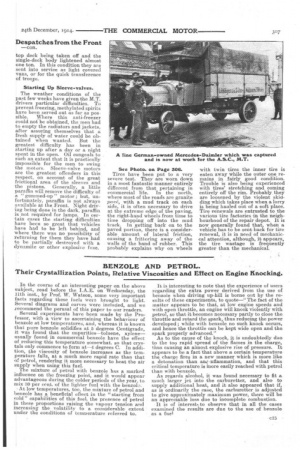BENZOLE AND PETROL.
Page 9

If you've noticed an error in this article please click here to report it so we can fix it.
Their Crystallization Points, Relative Viscosities and Effect on Engine Knocking.
In the course of an interesting paper on the above subject, read before the I.A.E. on Wednesday, the 11th inst., by Prof. W. Watson, some very important facts regarding these fuels were brought to light. Several diagrams and curves were included, and we 4-ecommend the perusal of this paper to our readers.
Several experiments have -been made by the Professor, with a view to ascertaining the behaviour of benzoic at low temperatures, and, whereas it is known that pure benzole solidifies at 5 degrees Oentigrade, it was found that the impurities—toluene, xyleneusually found in commercial benzole have the effect of reducing this temperature somewhat. so that crystals only commence to form at--4 degrees C. In addition, the viscosity of benzole increases as the temperature falls, at a much more rapid rate than that of petrol, rendering it more necessary to heat the air supply when using this fuel.
The mixture of petrol with benzole has a marked influence on the freezing point, and it would appear advantageous during the colder periods of the year, to_ mix 30 per cent. of the lighter fuel with the benzoba At low temperatures, too, the mixture of petrol and benzole has a beneficial effect in the "starting from cold" capabilities of this fuel, the presence of petrol in these proportions raising the vapour tension and increasing the volatility to a considerable extent under the conditions of temperature referred to.
It is interesting to note that the experience of users regarding the extra power derived from the use of benzole when driving up-hill is borne out by the results of these experiments, to quote—" The fact of the matter appears to be that, at low engine speeds and with open throttle, an engine will knock violently with petrol, so that it becomes necessary partly to close the throttle and retard the spark, thus reducing the power developed ; while with benzoic no such knock occurs, and hence the throttle can be kept wide open and the spark properly advanced." As to the cause of the knock, it is undoubtedly due to the too rapid spread of the flames in the charge, thus causing an almost explosive rise of pressure. It appears to be a fact that above a certain temperature the charge fires in a new manner which is more like a detonation than ant-nflammation, and that this critical temperature is more easily reached with petrol than with benzoic.
As regards alcohol, it was found necessary to fit a much larger jet into the carburetter, and also to supply additional heat, and it also appeared that if, as is ordinarily the case, the carburetter is adjusted to give approximately maximum power, there will be an appreciable loss due to incomplete combustion.
It is of interest.; to observe that in all the cases examined the results are due to the use of benzole as a fuel


















